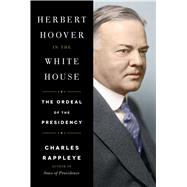Herbert Hoover in the White House

Herbert Hoover in the White House
- ISBN 13:
9781451648676
- ISBN 10:
1451648677
- Format: Hardcover
- Copyright: 05/10/2016
- Publisher: Simon & Schuster
Rent
Sorry, this item is currently unavailable.
Note: Supplemental materials are not guaranteed with Rental or Used book purchases.
Extend or Purchase Your Rental at Any Time
Need to keep your rental past your due date? At any time before your due date you can extend or purchase your rental through your account.
Summary
“A deft, filled-out portrait of the thirty-first president...by far the best, most readable study of Hoover’s presidency to date.” —Publishers Weekly
Rappleye’s surprising portrait of a Depression-era president Herbert Hoover reveals a very different figure than the usual Hoover, engaged and active but loathe to experiment and conscious of his inability to convey hope to the country.
Herbert Clark Hoover was the thirty-first President of the United States. He served one term, from 1929 to 1933. Often considered placid, passive, unsympathetic, and even paralyzed by national events, Hoover faced an uphill battle in the face of the Great Depression. Many historians dismiss him as merely ineffective. But in Herbert Hoover in the White House, Charles Rappleye draws on rare and intimate sources—memoirs and diaries and thousands of documents kept by members of his cabinet and close advisors—to reveal a very different figure than the one often portrayed. The real Hoover, argues Rappleye, just lacked the tools of leadership.
The Hoover presented here will come as a surprise to both his longtime defenders and his many critics. In public Hoover was shy and retiring, but in private he is revealed as a man of passion and sometimes of fury, a man who intrigued against his enemies while fulminating over plots against him. Rappleye describes him as more sophisticated and more active in economic policy than is often acknowledged. We see Hoover watching a sunny (and he thought ignorant) FDR on the horizon. FDR did not “cure” the depression, but he experimented with steps that relieved it. Most importantly he broke the mood of doom almost immediately. The Hoover we see here—bright, well meaning, energetic—lacked the single critical element to succeed as president. He had a first-class mind and a second-class temperament.
Herbert Hoover in the White House is an object lesson in the most, perhaps only, talent needed to be a successful president—the temperament of leadership.
Rappleye’s surprising portrait of a Depression-era president Herbert Hoover reveals a very different figure than the usual Hoover, engaged and active but loathe to experiment and conscious of his inability to convey hope to the country.
Herbert Clark Hoover was the thirty-first President of the United States. He served one term, from 1929 to 1933. Often considered placid, passive, unsympathetic, and even paralyzed by national events, Hoover faced an uphill battle in the face of the Great Depression. Many historians dismiss him as merely ineffective. But in Herbert Hoover in the White House, Charles Rappleye draws on rare and intimate sources—memoirs and diaries and thousands of documents kept by members of his cabinet and close advisors—to reveal a very different figure than the one often portrayed. The real Hoover, argues Rappleye, just lacked the tools of leadership.
The Hoover presented here will come as a surprise to both his longtime defenders and his many critics. In public Hoover was shy and retiring, but in private he is revealed as a man of passion and sometimes of fury, a man who intrigued against his enemies while fulminating over plots against him. Rappleye describes him as more sophisticated and more active in economic policy than is often acknowledged. We see Hoover watching a sunny (and he thought ignorant) FDR on the horizon. FDR did not “cure” the depression, but he experimented with steps that relieved it. Most importantly he broke the mood of doom almost immediately. The Hoover we see here—bright, well meaning, energetic—lacked the single critical element to succeed as president. He had a first-class mind and a second-class temperament.
Herbert Hoover in the White House is an object lesson in the most, perhaps only, talent needed to be a successful president—the temperament of leadership.






